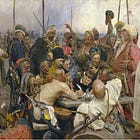A Caracole in Zaporizhzhia
Welcome to the Tactical Notebook, where you will find more than four hundred tales of armies that are, armies that were, and armies that might have been. If you like what you see, please share this post with your friends.
In The Battle for the First Position (La bataille pour la première position) Michel Goya describes the three echelons of Ukrainian mechanized brigades arrayed against Russian positions east of the Dnipro River. The first of these, he writes, consists of twelve brigades, each of which rides in a hundred or so armored vehicles. The second, composed of ten such formations, can be found just south of the city of Zaporizhzhia. The third, made up of five brigades, constitutes a strategic reserve.
After making an estimate of casualties on both sides of no-man’s land, Colonel Goya calculates that the first echelon should be able to operate, on the scale of the attacks that began on 5 June 2023, for three months. (Goya assumes that each brigade can lose thirty percent of its men before it is deprived of the capacity to fight.)
This is not to say that Goya presumes that each mechanized brigade will be ordered to attack until it is rendered hors de combat. Rather, he imagines a regular program of rotation in which brigades of the second echelon (and, perhaps, the strategic reserve) replace brigades withdrawn from the first echelon for the sake of rest and reconstitution.
The image that Goya’s model brings to mind is that of the caracole. Taking its name from the Spanish word for “snail” [caracol], this drill, popular in the century that ended in 1650 or so, allowed horsemen to take turns firing their pistols at a slow-moving target, thereby subjecting it to a sustained hail of bullets. (This scene, from the film Alatriste, does a good job of showcasing this technique. It also depicts the pedestrian counterpart of the caracole, the countermarch.)





